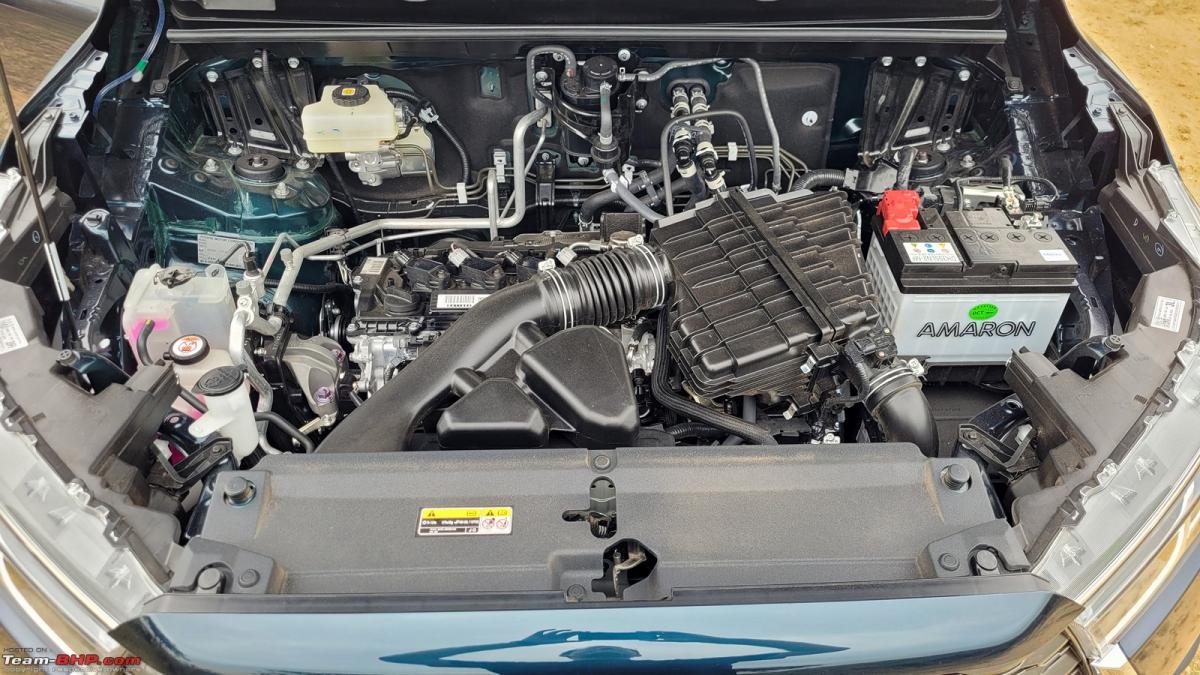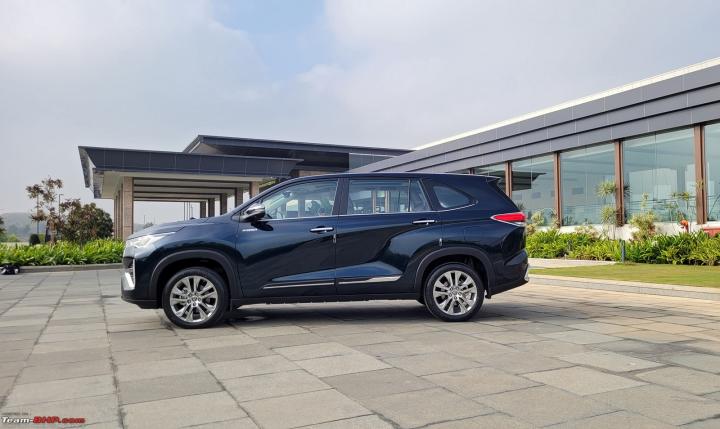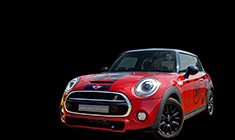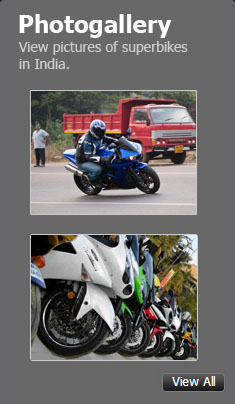News
Toyota Innova Hycross: Observations after a day of driving
The Innova Hycross' NVH levels are impressive. The car does a good job of keeping most noises out of the cabin most of the time.
Driving the Innova Hycross 2.0L Hybrid

The Toyota Innova Hycross Hybrid is powered by a 5th Generation Self-Charging Strong Hybrid Electric System with TNGA 2.0-Litre 4-cylinder VVTi petrol engine. The car has a 1.7 kWh Ni-MH battery that powers the electric motor. Its combined power is 184 BHP and motor torque is 206 Nm. The engine is paired to an e-Drive transmission with sequential shift.
With your foot on the brake, press the engine start button. It doesn't result in the usual sound of a starter cranking the engine to life; it's eerily silent & for those who haven't experienced electric or hybrid cars before, this does take a little getting used to. Slot the gear lever into D and you're all set to roll.
One of the first things you notice is the absence of a rev counter. It sure feels weird to drive a car without the rpm needle moving up & down. The instant torque from the electric motor ensures that the Innova Hycross immediately darts forward. Low-end torque is good. In heavy traffic, you can drive the car without any throttle input. The petrol engine turns on only when extra shove is required, or if the batteries are below a certain charge level. The engine also switches on when the car crosses ~40 km/h. While the insulation is superb & regular folk won't know, enthusiasts will notice when the petrol engine suddenly kicks in. Whether it is driving in bumper-to-bumper traffic or closing gaps, the Hycross does it effortlessly. The e-Drive transmission provides a seamless experience in the city. As there aren't any actual gear shifts taking place, the drive feels amazingly smooth. Throttle response is good and the rubber-band effect is well-controlled with a light foot on the accelerator. These traits make the Innova Hycross very easy to drive in the city.
On the open road too, the Innova Hycross provides satisfactory performance. There is enough power and torque on offer to keep up with the traffic with ease. The powertrain responds well to throttle inputs and power is always available. Outright performance is strong. Toyota claims that the Hycross will do a 0-100 km/h sprint in under 10 seconds, which we are tempted to believe. Slow-moving vehicles are overtaken without any drama. In terms of cruisability, the Hycross proves to be a good mile muncher. It can maintain triple-digit speeds effortlessly. At the same time, the cabin is quiet, cutting out most of the outside noises.
The Hycross gets drive modes that basically alter the throttle response as well as the behaviour of the internal combustion engine. There is a dedicated EV mode button that will let you drive the car as an EV for the max distance possible. However, if you are heavy on the throttle or the car crosses ~40 km/h or the battery's state of charge is too low, the system will go back from EV mode to hybrid mode.
Apart from the EV mode, there are 3 drive modes: Normal, Eco and Power. These 3 modes alter the throttle response.
The normal mode is the default mode which is in between the middle of Eco and Power modes. It works well in town and on the highway and offers a good balance between efficiency and performance. In fact, you really don't need to change it unless you're driving uphill or want to overtake a vehicle quickly on an undivided highway.
In Eco mode, the internal combustion engine doesn't come on as easily unless you press the throttle a lot more. The response is lazier and it tries to keep it in hybrid mode with the internal combustion engine only charging the battery and not sending power to the wheels unless the accelerator is pressed very firmly.
In Power mode, it's the opposite. Even with a light dab of the throttle, the internal combustion motor comes alive and assists the power delivery. On undivided highways, this is the mode to use to pull off safe overtakes. Throttle response is much sharper and you rarely see the internal combustion engine turning off. Of course, this mode impacts fuel efficiency the most. Don't use this mode in the city as power delivery can get a little spiky.
The gearbox also has a manual mode. You can use the gear shifter or the paddles behind the steering wheel to change gears. You'll like the engine braking on offer. The gearbox has an "S" mode too in which the transmission holds the gears for a little longer than in the regular D mode.
Thick insulation has been provided under the bonnet:

Engine bay has a lot of free space:

Noise, Vibration & Harshness (NVH)
The Innova Hycross' NVH levels are impressive. The car does a good job of keeping most noises out of the cabin most of the time. It's only when you press the accelerator harder that you can hear the 2.0L petrol engine. However, it is never loud and intrusive and the occupants of the car do not have to raise their voices while talking to each other. In fact, the insulation is so good that on the go, even the horn of the car is heard very faintly inside the cabin! We did not feel any vibrations even when the petrol motor came on.
Wind noise, road noise and suspension noise are well-contained.
Mileage & Fuel economy
In our short drive, which included some fast driving and lots of idling, we saw 14.3 km/l on the MID. With better driving, we are pretty sure that the hybrid will deliver much better FE figures. Toyota claims that the car can deliver 21.1 km/l.
Suspension

Ride Comfort
The Toyota Innova Hycross gets a MacPherson strut suspension at the front and a semi-independent torsion beam suspension setup at the rear. The suspension is well-tuned to provide a compliant ride. However, the car rides on 18" rims with 225/50 section tyres. While the width of the rubber is fine, the sidewalls are just too short. This results in more bumps and potholes being transmitted to the occupants than we would like. While the ride is still fine, we are pretty sure that it would be better with taller rubber. Even with speeds increasing, the ride remains compliant. We didn't get to check the ride out on very bad roads though.
Handling & Dynamics
High-speed stability is very good. Even at 120 km/h, there is no floatiness or nervousness displayed by the Hycross. While we did not get a winding road to try out the car's handling, we did try some quick lane changes on an empty stretch of road. As expected, the Hycross has more body roll compared to a sedan or crossover. But, it is noticeably lesser than the old body-on-frame Innova Crysta. Again, the tyres provide good grip and the car sticks to its line through curves. Overall, the Hycross certainly feels more car-like to drive compared to its predecessor.
Steering
The Innova Crysta had a very heavy hydraulic steering. This made the car cumbersome to drive at low speeds. The Hycross gets an electric steering that is well-calibrated. It is light at slow speeds and gets heavier as the speed goes up. This along with the healthy rake and reach adjustment, makes the Hycross way better to steer than the old Innovas. That said, it could do with more feedback.
Braking
Being a hybrid, braking is different compared to conventional cars. With disc brakes all around, the stopping power is good. But the braking needs time to get used to. It's not easy to get a linear braking response. Sometimes you hit a bump faster than you intended to since the braking isn't linear. This needs getting used to. It will catch you off guard initially, but after a while, you get accustomed to it and change your braking style accordingly.
Continue reading the discussion on the Toyota Innova Hycross on our forum.



















